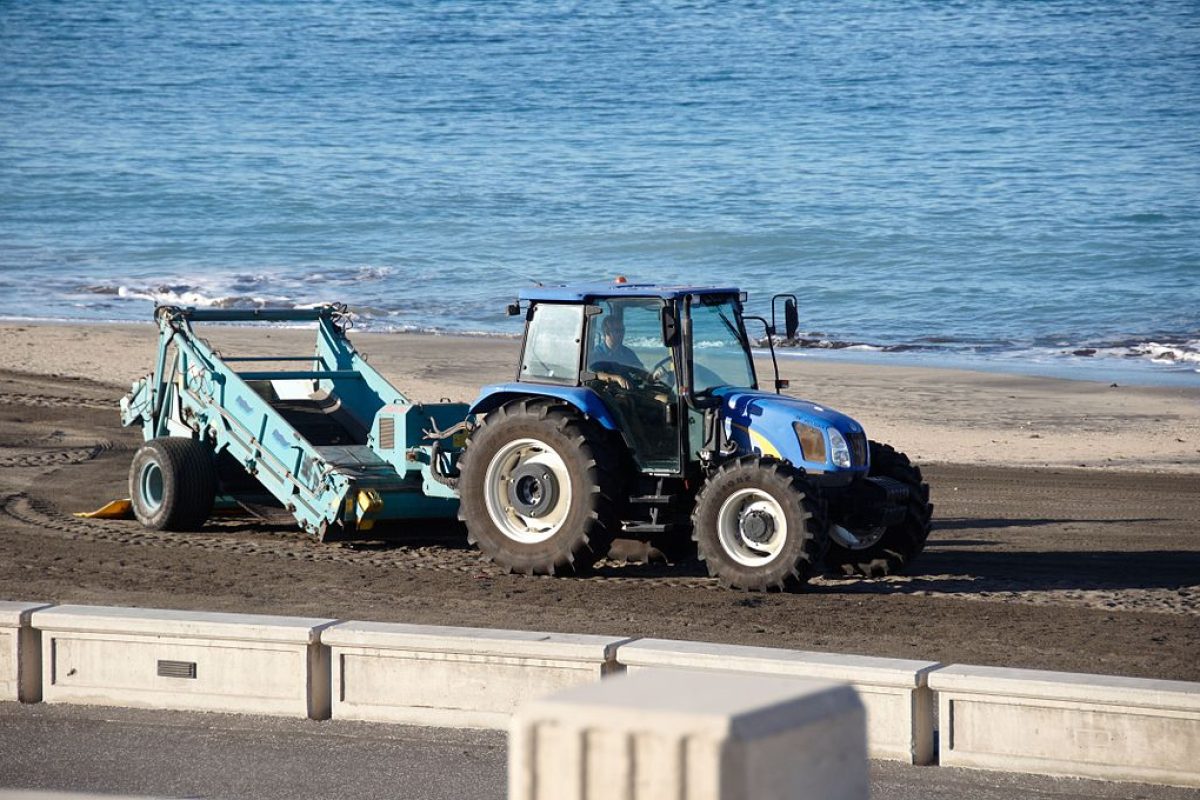photo credit: Wouter Hagens, CC BY-SA 3.0 <https://creativecommons.org/licenses/by-sa/3.0>, via Wikimedia Commons
On early mornings in Long Beach, before the crowds set up umbrellas and lifeguards take their posts, a different kind of worker takes to the sand. Sleek, teal-blue Beach-Tech machines can now be seen cruising the shoreline, quietly sifting and cleaning the sand. These machines, some tractor-towed and others self-propelled, are quickly becoming an essential part of how the city maintains safe, beautiful, and inviting beaches for millions of visitors each year.
Beach-Tech, a global leader in beach cleaning equipment, has been perfecting this specialized equipment since 1991. Their machines are designed to tackle everything from cigarette butts and bottle caps to broken glass, syringes, and even oil residue. Unlike traditional manual cleanup efforts that rely on volunteer groups or small crews, Beach-Tech machines can cover huge stretches of sandy areas in a fraction of the time. The technology represents a major shift in how Long Beach approaches shoreline maintenance—one that blends efficiency, safety, and sustainability.
Advanced Beach Cleaning Machines in Action: Leading the Coastal Cleanup Effort
Long Beach is home to some of the busiest urban beaches in California. With heavy foot traffic, beach volleyball courts, seasonal festivals, and year-round tourism, keeping the shoreline clean is a constant challenge. Traditional crews do their best, but the sheer volume of litter, pollution, and marine debris makes it nearly impossible to keep pace. That’s where Beach-Tech comes in.
The company manufactures several models of beach cleaners, each tailored for different environments. The larger tractor towed and tractor attached units can clean up to 30,000 square meters per hour, digging as deep as 30 centimeters below the surface. Their working widths allow them to cover wide expanses of sand efficiently.
For tighter spaces around piers, boardwalks, or lifeguard stations, the self-propelled Beach-Tech 5500 and the compact walk-behind Sweepy Hydro offer maximum maneuverability. This flexibility means that the entire beach—wide expanses and small nooks alike—can be addressed with the same level of care.
Cleaner Beaches, Safer Communities: The Environmental Impact of Beach Cleaning Technology
The benefits of this technology extend far beyond aesthetics. While it’s nice to enjoy smooth, trash-free sand, the real advantage is safety. Hidden hazards like broken glass, metal shards, or syringes pose risks for barefoot beachgoers. Cigarette butts, one of the most common forms of litter, not only spoil the look of the beach but also leach toxic chemicals into the environment. By filtering sand at such a fine level, Beach-Tech machines dramatically reduce these risks, making the shoreline safer for families, athletes, and visitors of all ages.
For Long Beach, which relies on tourism and recreation as key economic drivers, cleaner beaches also translate into a stronger reputation and higher visitor satisfaction. A beach that looks and feels well maintained encourages return visits, community pride, and healthier ecosystems.
Smart Equipment Choices: Matching the Right Beach Cleaner to the Job
Each type of equipment has its place. The sifting machine is ideal for dry sand, where it can efficiently process and filter particles without disturbing the underlying soil. For wet sand or coastal zones with higher marine debris content, machines with vibrate functions and reinforced screens are better suited.
Some models even equip cities for multi-season use. Machines can mount to a vehicle or even be repurposed for snow or turf cleanup outside of summer months—adding to their cost-effectiveness and year-round value.
Protecting Public Health While Preserving Ecosystems
Of course, beach cleaning is not without its challenges. Coastal ecosystems depend on natural materials like seaweed and driftwood—known as wrack—that wash ashore and provide food and shelter for native wildlife. Over-grooming a beach can strip away these resources, disrupting delicate dune systems and biodiversity.
This is why Long Beach is working to strike a balance. The deployment of Beach-Tech machines is being paired with careful scheduling and zoning, ensuring that high-traffic areas are thoroughly cleaned while certain ecological zones are left to function naturally. By using the right machines for the right areas, the city can maintain a clean and safe shoreline for people without compromising its commitment to sustainability.
The Future of Sand Cleaning in Long Beach
As more cities adopt Beach-Tech technology, Long Beach is positioning itself as a leader in modern, eco-conscious shoreline management. The investment in these machines represents not only a practical solution to litter and safety concerns but also a broader vision of what urban coastal stewardship can look like in the 21st century.
The versatility of Beach-Tech’s lineup adds another layer of value. Machines like the Sweepy Hydro can even be adapted for non-beach uses, functioning as lawn mowers or snow blowers in the off-season. This multi-functionality ensures that the city gets maximum benefit from its investment, stretching taxpayer dollars while keeping public spaces well maintained year-round.
Why This Matters
Clean beaches are more than just pleasant—they’re essential. They protect public health, boost local economies, and preserve ecosystems. In a city like Long Beach, where the ocean is woven into the cultural identity, the arrival of Beach-Tech machines signals a new chapter. It’s a chapter where innovation and sustainability meet, where technology supports community needs, and where residents and visitors alike can enjoy safer, cleaner, and more welcoming shorelines.
So the next time you head down to Long Beach and feel the smooth, debris-free sand beneath your feet, remember that it’s not just the tide that keeps our beaches pristine. It’s also the quiet, steady work of advanced machines like those from Beach-Tech—bringing global innovation to our local coast.


